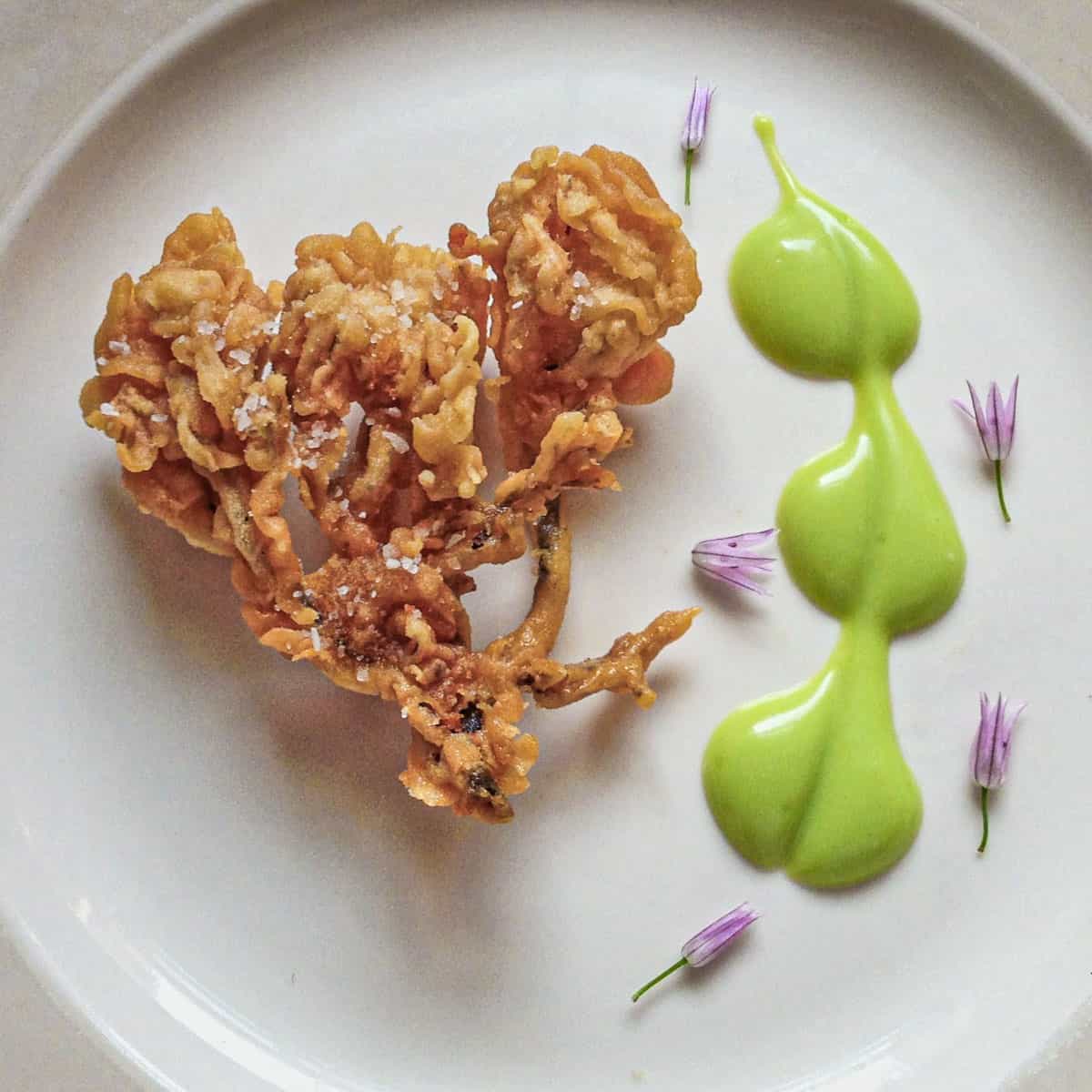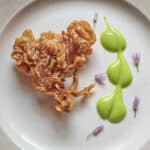After the morels, the first mushrooms I start to notice fruiting everywhere in Minnesota are white crown corals. Crispy fried with a little flavored aioli is one of the most popular things I've done with them.
The trick here is to find preparations that keep their integrity as much as possible. Trying to fry them crisp took me a couple different tries to really get it right, they are really finicky. If the corals are fried in a very light dusting or dredge, the mushroom body turns black, which is a bit off-putting, although they still taste good.
When fried in a more heavy batter, they almost disappear into it and it's impossible to distinguish their texture. I had to figure out a way to possibly preserve their color, and at the same time keep their textural integrity. In hindsight, tempura would be a great way to fry these too.
I experimented with a number of different breading/battering techniques until I got it right, here are some I played with:
1. Dipped first in flour, then pure beaten egg, then flour again:
Mushroom keeps color and doesn't darken, but breading is too heavy
2. Dipped only in flour and fried:
Mushroom is nice and crisp, giving off a pleasant flavor, but turns black in the pan
3. Dipped in a light beer batter, then in flour and deep fried:
Batter takes too long to cook, by the time the batter is golden brown, the mushroom is too wilted and overcooked to taste like anything
4. Dipped in flour, then egg and fried:
Egg overcooks, getting a bit tough and mushroom still turns black
5. Dipped in flour, then egg thinned with water, then floured and fried
This was the best I found. Loosening the egg with some water allowed the coating to be lighter and not absorb so much flour.
As for the condiment here, I have been picking the chive blossoms from a large bush in the backyard religiously. Since both the green oniony stem and the pretty pink blossoms can both be used, I show them in two different ways here. The chives are made into an oniony mayonnaise, The blossoms are simply picked fresh off of the plant, and sprinkled on for punchy, onion kick.
Related Posts
- Eating Coral Mushrooms or Ramarias
- Pink Tipped Coral Mushrooms / Ramaria botrytis
- Cauliflower Mushrooms
Crispy Fried Coral Mushrooms, with Chive Aioli
Ingredients
- ½ lb Coral Mushrooms
- Chive Aioli recipe follows
- Kosher salt and fresh ground pepper
- ½ cup flavorless oil for frying like grapeseed or canola
- 1 recipe chive aioli follows
- Chive Blossoms to garnish
- All purpose flour as needed for dredging
- 2 large eggs beaten with 2 tablespoon water
Instructions
- Separate the coral mushrooms into pieces about the size of a chicken egg.
- Clean the coral mushrooms with a brush and if needed dip and swish in water.
- Dust your coral mushrooms lightly in flour, dip in the egg, then in the flour again.
- Heat a saute pan on medium low with cooking oil. Test the heat of the oil by sprinkling some flour in it, when it sizzles, turn the heat to medium-high, then add the coral mushrooms and fry 3-4 minutes on each side, or until golden. Adjust the heat as necessary here to brown the mushrooms.
- Remove the corals from the pan sprinkle with kosher salt, and allow to drain on a paper towel for a few seconds to remove excess oil. Serve immediately with the chive aioli on the side.
Chive Aioli
Makes ½ cup of Aioli
- A handful of fresh chives, about ¼ oz
- ⅛ cup flavorless oil
- 1 cup prepared mayonnaise
Method
- Blanch the chives in boiling salted water for 2 seconds, then remove and chill in an ice bath. Remove the chives from the ice water and wring dry. Mince the chives finely.
- Puree the chives in a blender or small food processor until they are well pureed, be careful not to puree them too long in the food processor or blender though, since this will heat them and turn their color brown and ugly, as well as making it bitter.
- Pour the pureed chives and oil into a small container like a bowl or custard dish and refrigerate overnight.
- The next day, pour the pureed chives and oil into a fine small strainer, allow the oil to drip though without pressing on it for a few hours. This will yield a tablespoon or two of deep green, strongly flavored oil.
- Stir the chive oil into the mayonnaise, then season to taste with salt. The aioli can be refrigerated and held for days at this point.
- Before serving, lightly stir in 2 teaspoons of champagne vinegar, which will give it acid. Don't put the vinegar in days before you use the aioli though, since the vinegar will turn the color brown and destroy the chlorophyll.



J L Hughes
Hi Alan,
We just started foraging mushrooms this year. In our camp alone we have found Chicken of the Woods, oyster fungi, and now coral tooth fungus on a dead hardwood tree. WOW! there were a lot on a three-foot piece of wood. We are going to fry them tonight along with our dinner and hope we have something spectacular!
Alan Bergo
Camping was one of the first times I found lots of mushrooms too.
Matt
Hey there! I just started getting into foraging this spring. I found my first coral mushrooms yesterday and cooked these up today using your recipe. Amazinggg! Just wanted to say thank you for the recipe. I appreciate you!
Alan Bergo
Hey thanks Matt.
K in KS
Too much batter - probably my fault - can't taste the mushroom. These are hard to batter consistently because of the shape. Next time I'll just dredge in flour. I don't mind black.
Maggie Cain
I loved this recipe. I made a few small batches of these to experiment, and ended up putting garlic powder and salt into the flour for taste, then serving with a squeeze of lemon. The dipping sauce I landed on was a quick and dirty aioli, just mayo, garlic powder, and lemon juice. I'll definitely try your chive thing when I have the time to do it properly.
I did have to keep the oil at a higher temperature than "low" would maintain, in order to get them crispy and golden.
Alan Bergo
Thanks Maggie, yes that looks like a typo. I adjusted it. Thanks for the copy edit.
Joel Kershner
Your recipe for crown coral mushrooms was excellent! I really appreciate that you tried and discarded a number of ways of cooking it before arriving at the final recipe. I’ve enjoyed finding and identifying nimerous species of fungi, edible or not, in the woods for many decades, but usually don’t know the best way of cooking a particular species so this success was a real treat for me
Alan Bergo
Thanks Joel.
Paul
I have just found out this is toxic!!! And I was so sure is edible by traditional pickers in Romania. What do you say?
Alan Bergo
Artomyces pyxidatus, as pictured here, harvested in North America, is eaten annually by many, many mushroom hunters without issue. I’ve eaten this mushroom for at least ten years. There are similar looking mushrooms that grow on the ground that could cause problems you may be confusing them with. Go back to where you heard that rumor, find the Latin name that is being referred to, and we can probably clear up any confusion.
Christina
I'm so glad I found this site! My woods are filled with wonderful mushrooms so recipes are always welcome. In the Spring, it's wild leeks (ramps), trout lily , then fiddleheads and mushrooms start. I spend yesterday afternoon in the woods under a gentle rain. collecting crown tipped coral mushrooms. 🙂
Anne
Well!!! This recipe is another reason to look at a rarely seen Yukon summer of never ending monsoonian rains, as the megafun festival of mushroom that it has become! Thanks much for testing the techniques, ahead of the game!
It's a must to preserve the delicate beauty of the coral shrooms! The 10lbs specimen I have found today will be a prized appy tomorrow. So, so love your writing and musings and research and insta, with all their inspiration. Anne
Alan Bergo
Do you have coral mushrooms (Ramaria there?) or Artomyces pyxidatus? Both are good but I prefer Ramaria.